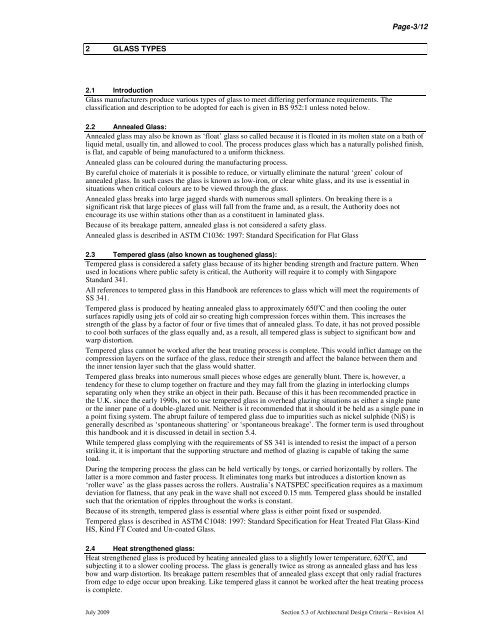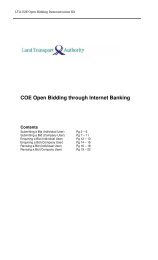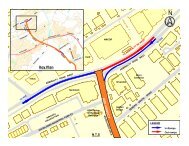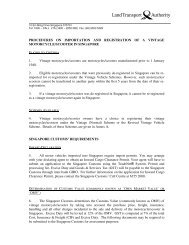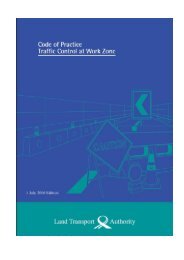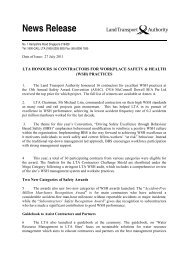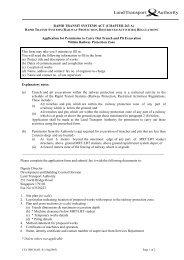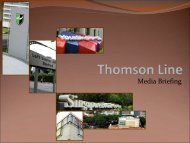ADC Section 5 - Support Design Guidelines - Land Transport Authority
ADC Section 5 - Support Design Guidelines - Land Transport Authority
ADC Section 5 - Support Design Guidelines - Land Transport Authority
- No tags were found...
You also want an ePaper? Increase the reach of your titles
YUMPU automatically turns print PDFs into web optimized ePapers that Google loves.
Page-3/122 GLASS TYPES2.1 IntroductionGlass manufacturers produce various types of glass to meet differing performance requirements. Theclassification and description to be adopted for each is given in BS 952:1 unless noted below.2.2 Annealed Glass:Annealed glass may also be known as ‘float’ glass so called because it is floated in its molten state on a bath ofliquid metal, usually tin, and allowed to cool. The process produces glass which has a naturally polished finish,is flat, and capable of being manufactured to a uniform thickness.Annealed glass can be coloured during the manufacturing process.By careful choice of materials it is possible to reduce, or virtually eliminate the natural ‘green’ colour ofannealed glass. In such cases the glass is known as low-iron, or clear white glass, and its use is essential insituations when critical colours are to be viewed through the glass.Annealed glass breaks into large jagged shards with numerous small splinters. On breaking there is asignificant risk that large pieces of glass will fall from the frame and, as a result, the <strong>Authority</strong> does notencourage its use within stations other than as a constituent in laminated glass.Because of its breakage pattern, annealed glass is not considered a safety glass.Annealed glass is described in ASTM C1036: 1997: Standard Specification for Flat Glass2.3 Tempered glass (also known as toughened glass):Tempered glass is considered a safety glass because of its higher bending strength and fracture pattern. Whenused in locations where public safety is critical, the <strong>Authority</strong> will require it to comply with SingaporeStandard 341.All references to tempered glass in this Handbook are references to glass which will meet the requirements ofSS 341.Tempered glass is produced by heating annealed glass to approximately 650 o C and then cooling the outersurfaces rapidly using jets of cold air so creating high compression forces within them. This increases thestrength of the glass by a factor of four or five times that of annealed glass. To date, it has not proved possibleto cool both surfaces of the glass equally and, as a result, all tempered glass is subject to significant bow andwarp distortion.Tempered glass cannot be worked after the heat treating process is complete. This would inflict damage on thecompression layers on the surface of the glass, reduce their strength and affect the balance between them andthe inner tension layer such that the glass would shatter.Tempered glass breaks into numerous small pieces whose edges are generally blunt. There is, however, atendency for these to clump together on fracture and they may fall from the glazing in interlocking clumpsseparating only when they strike an object in their path. Because of this it has been recommended practice inthe U.K. since the early 1990s, not to use tempered glass in overhead glazing situations as either a single paneor the inner pane of a double-glazed unit. Neither is it recommended that it should it be held as a single pane ina point fixing system. The abrupt failure of tempered glass due to impurities such as nickel sulphide (NiS) isgenerally described as ‘spontaneous shattering’ or ‘spontaneous breakage’. The former term is used throughoutthis handbook and it is discussed in detail in section 5.4.While tempered glass complying with the requirements of SS 341 is intended to resist the impact of a personstriking it, it is important that the supporting structure and method of glazing is capable of taking the sameload.During the tempering process the glass can be held vertically by tongs, or carried horizontally by rollers. Thelatter is a more common and faster process. It eliminates tong marks but introduces a distortion known as‘roller wave’ as the glass passes across the rollers. Australia’s NATSPEC specification requires as a maximumdeviation for flatness, that any peak in the wave shall not exceed 0.15 mm. Tempered glass should be installedsuch that the orientation of ripples throughout the works is constant.Because of its strength, tempered glass is essential where glass is either point fixed or suspended.Tempered glass is described in ASTM C1048: 1997: Standard Specification for Heat Treated Flat Glass-KindHS, Kind FT Coated and Un-coated Glass.2.4 Heat strengthened glass:Heat strengthened glass is produced by heating annealed glass to a slightly lower temperature, 620 o C, andsubjecting it to a slower cooling process. The glass is generally twice as strong as annealed glass and has lessbow and warp distortion. Its breakage pattern resembles that of annealed glass except that only radial fracturesfrom edge to edge occur upon breaking. Like tempered glass it cannot be worked after the heat treating processis complete.July 2009<strong>Section</strong> 5.3 of Architectural <strong>Design</strong> Criteria – Revision A1


